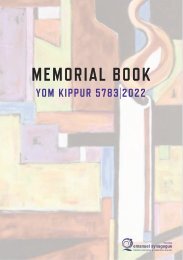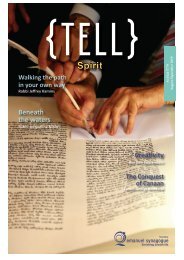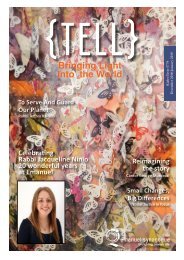TELL - December 2019 - February 2020
TELL - the magazine of Emanuel Synagogue, Sydney The Identity issue
TELL - the magazine of Emanuel Synagogue, Sydney
The Identity issue
You also want an ePaper? Increase the reach of your titles
YUMPU automatically turns print PDFs into web optimized ePapers that Google loves.
{NANNAGOGY}
Larraine Larri, a member of Emanuel Synagogue, has been researching, for her PhD, the
phenomenon of women of grandmother age quietly taking up the fight for Climate Action.
They call themselves the “Knitting Nannas” and they began in 2012 in the Northern Rivers,
NSW, protesting coal seam gas (CSG) mining. There are now almost 40 groups across
Australia. Larraine is particularly interested in the way these women are learning to be
environmental activists and at the same time educating others: she calls this Nannagogy!
Here is a fascinating excerpt from her most recent article, Nannagogy: Social movement learning for older women’s
activism in the gas fields of Australia published in the Australian Journal of Adult Learning (April 2019):
A MORNING IN THE PILLIGA
WITH THE NANNAS
…in August 2017, (Larraine)
was attending the third Knitting
Nannas Nannual conference in
the town of Narrabri, New South
Wales. As an Honorary Nanna,
Larraine was invited to visit the
endangered Pilliga State Forest in
the company of thirty Nannas.
‘About thirty of us are being guided
by two younger environmental
activists, Dan Lanzini and Jo Holden.
I’d say they’re in their mid-thirties and
their knowledge, commitment and
passion is impressive. They’ve made
it their mission to spend as much
time as possible in the Pilliga bearing
witness to CSG mining company
Santos fracking operations hidden
deep in the forest. Nannas tell me this
is not easy. Jo is a mother of young
children. Her husband and family
support her as much as they can. Dan
often camps for days in the Pilliga
but has to leave for contract work so
that he can keep coming back. He
seems very independent and alone.
We begin our tour, stopping at
CSG extraction well sites, vents and
flares. Forest clearings bounded by
high mesh fences; industrial metal
structures; eerie silences punctuated
by intermittent buzzing, clicking,
hissing; the occasional CCTV; faint
chemical smells (not the fresh forest
air you’d expect). Getting too close
makes you feel sick and headachy.
The Nannas have come prepared
and put on their face masks. I’ve got
mine. A local Gomeroi man who’s
come along on the tour tells us he
remembers exploring and camping in
the forest as a child. That was thirty
32
years ago and that’s how long it’s
been since the first wells and flares
were put in by Eastern Star (bought
out by Santos). The day before we
heard from Gomeroi women about
how sacred the Pilliga is to them.
They described it as their heartland,
their responsibility to protect
and care for. A highly significant
Dreaming site, it’s said to contain
an underground gigantic crocodile
– safe as long as it stays where it is,
but with catastrophic consequences
if set free. How prophetic! I’m
struck by the reality of dispossession,
stolen lands, loss of life purpose.
‘What are they doing with the CSG
from this well?’ asks a Nanna.
‘Nothing’ says Dan, ‘It’s just for
show when they bring investors
in. Been like this for years.’
At each stop, the Nannas make a
point of photographing their presence
– documenting the scenes so they
can show others. They gather in
various formations holding their
knitted banners, fists raised or arms
crossed in defiance. As they leave
I see yellow and black woollen
knotted threads across gates. Soft
barriers reclaiming spaces, symbolic
memorials of their anger and fulfilling
their 'Nannafesto' to ‘bear witness’.
Back in the cars we’re heading for
the dead zones. Created sixteen
years ago when contaminated water
from exploratory wells spilled from
evaporation ponds onto huge sections
of forest. Twenty-two sites in all, we
only see two. I’m walking through a
grey and black denuded landscape,
eerily more silent than a graveyard.
It feels immediately desolate. At
my feet, an expanse of dead wood,
grey mulch, and patches of muddy
sludge criss-crossed by irrigation
pipes and the odd dying bush or
leafless bare tree. In the far distance
a fence and thick forest beyond.
The demarcation line is dramatic.
‘Look down’, says Dan, ‘tell me if you
can see any ants or other insect life
or any signs of animal activity’. ‘He’s
right’ we murmur to one another,
‘there’s nothing alive here’. We see
signs saying ‘Keep out, rehabilitation
area’. Despite regular attempts with
water, dispersant chemicals, and bush
regeneration nothing has worked, it’s
still a dead zone. I’m shocked at how
my emotions of disbelief then sadness
affect me. I’ve never been here before,















